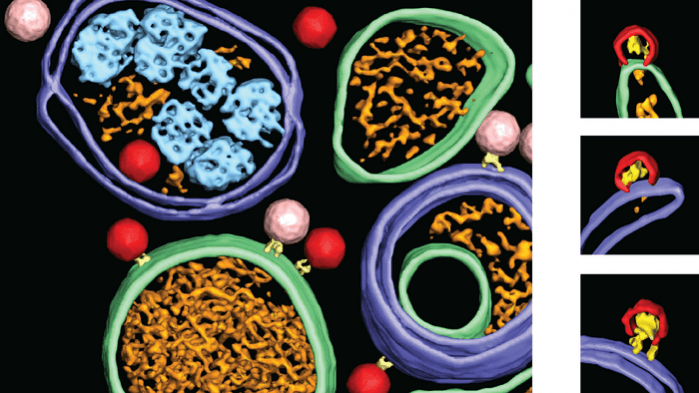Just when poliomyelitis, also known as polio, was considered to be eradicated in all developed countries, the disease reared its ugly head in two of the largest cities in the world recently: London and New York. This re-emergence has renewed interest in the study of poliovirus-caused infection. Providing new insights into the mechanism of the dreaded disease, scientists have found how the poliovirus behaves after infecting cells.
According to a new multi-institutional study led by researchers from Umeå University, Sweden, the poliovirus tricks infected cells into producing new viral particles by reprogramming an essential cellular process known as autophagy. It was also learnt that two proteins—VPS34 and ULK1—played a crucial role in the replication of the virus.
"We now get a completely different understanding of how the virus acts and thus also better opportunities for research to perhaps find new ways to stop the virus' progress in the future," said Dr. Lars-Anders Carlson, corresponding author of the study, in a statement. The findings were published in the journal Nature.
A Deadly Disease

The poliovirus belongs to a genus of viruses known as enteroviruses. These single-stranded RNA viruses cause several diseases in human beings such as Bornholm disease, Encephalitis, Herpangina, and Myocarditis, among others. The poliovirus has three serotypes: type 1, type 2, and type 3. Humans are known to be the only hosts of the virus. What makes the virus particularly tricky is that it evades the immune system, and can overwhelm the body's immune response through rapid multiplication.
Polio is mostly transmitted through contact with the faeces of infected individuals. Spreading from person to person, the virus can infect an individual's spinal cord and can cause paralysis or even death. Currently, there is no cure for the disease, and vaccination is the only way to prevent its contraction.
While polio is largely eradicated in most parts of the world, particularly in developed countries, it persists in some countries in Asia, Africa, and the Middle East. Unfortunately, in 2022, polio was detected in sewage samples collected in London, Britain, and New York, USA–indicating the return of the virus in developed countries. One case of polio-related paralysis was also reported in New York.
Looking Deep into Infected Cells

It is known that enteroviruses such as the poliovirus cause disarray within infected cells. They rapidly alter the cytoplasmic membrane (also known as the cell membrane) in order to create an ideal environment for viral replication. Sadly, technological limitations prevented scientists from discerning how this occurs deep within cells for several years.
However, the availability of the advanced cryo-electron microscopy technology at Umeå University made it possible for researchers to observe how the poliovirus infects and gains control of human cells. Using the sophisticated imaging technique, the team was able to capture three-dimensional images of cells infected with the poliovirus.
Through the study, the authors identified the site within cells where the poliovirus creates new viral particles. They did so by analyzing half-assembled viruses. Interestingly, the "virus factory" within cells were surfaces that were associated with autophagy (a self-degradative process through which cells eliminate damaged or dysfunctional components, or foreign bodies, from their cytoplasm).
Autophagy also helps in the destruction and removal of intracellular pathogens; thereby, serving as a defense mechanism as well. However, the poliovirus was able to reprogram this protective process for the production of its copies. "We were surprised to see how the virus transforms processes in the cell that are otherwise used to destroy viruses into instead producing new viruses," stated Dr. Carlson.
Carefully Packaging Viral Particles

The authors observed that certain proteins played a crucial role in the replication of the poliovirus, particularly VPS34 and ULK1. VPS34 is utilised by the virus to assemble new viral particles. Upon the inhibition of VPS34, the virus was unable to assemble whole viruses successfully and managed to produce only half-formed viral particles. On the other hand, ULK1 decelerates the production of viruses. When the team inhibited this protein, the poliovirus' number increased exponentially. This confirmed that the polio virus causes this cellular 'brake' to fail.
Like in any virus, virions—complete viral particles consisting of DNA or RNA surrounded by a protein shell and representing the infective form of a virus— produced within infected cells following the replication of the poliovirus, must be released in order to infect new cells. This occurs through the transportation of these particles in small sacs or packages known as vesicles.
The scientist made an unexpected discovery while studying this aspect of the infection: the particles loaded into vesicles were carefully selected. It was found that only perfectly formed virions that possess the virus' genetic material were packed into the vesicles, and flawed particles were left out. Thus, through this meticulous sorting process, the poliovirus proliferates more effectively.
"The new knowledge we contribute about the role of autophagy in virus formation can provide new insights for the development of future antivirals that could be a complement to vaccines. We have good reason to believe that our findings hold true for the large group of viruses to which poliovirus belongs, the enteroviruses. There is no vaccine against most enteroviruses, but an antiviral that acts on the autophagy system could be effective against many of them. However, there is still a long way to go," concluded Dr. Carlson.

















